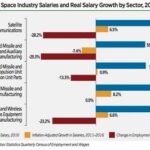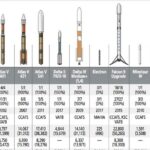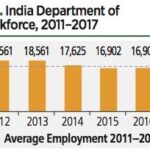Browse Resources by Year
Surface imaging satellites observe, monitor, and track changes and developments on the Earth’s surface using a variety of optical or electronic imaging capabilities. EO satellites…
Read MoreIn 2016, private industry space companies in the United States employed 128,163 professionals. This is 1.6% fewer than in 2015 . . .
Read MoreThe U.S. Space workforce is composed of more than 173,000 workers across the commercial, civil, and national security sectors. . .
Read MoreThe U.S. share of global orbital launch activities continued to grow, from 26% in 2016 to 33% in 2017. In 2017, the nation’s launch service providers. . .
Read MoreIndia’s Department of Space, which includes the Indian Space Research Organisation (ISRO), employed 16,072 employees in 2017. . .
Read MoreDuring 2016, China launched its latest space station, Tiangong-2. Chinese taikonauts lived aboard the new space station for 30 days before returning to…
Read MoreThe privately owned Bigelow Expandable Activity Module (BEAM), launched in 2016, remained attached to the ISS in 2017. NASA originally contracted Bigelow Aerospace to test…
Read MoreOnly three satellites with a dedicated meteorological focus were deployed during 2017—less than 1% of 443 spacecraft deployed during that year. It was also a drop from the number of meteorology satellites deployed in previous years. In 2016, the number of meteorology satellites . . .
Read MoreThe International Space Station (ISS) continued to be an active inhabited space laboratory during 2017. International teams of engineers, researchers, and scientists…
Read MoreThe Korea Aerospace Research Institute (KARI) had a 2017 budget of 659.3 billion won (US$576.0 million), a decrease of 13% from its 2016 budget of 746.4 billion won (US$646.7 million).
Read More


